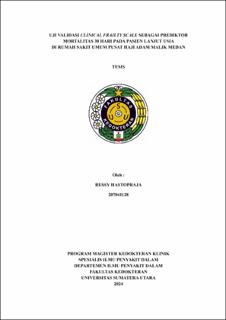| dc.contributor.advisor | Purba, Ariantho Sidasuha | |
| dc.contributor.advisor | Ariestine, Dina Aprillia | |
| dc.contributor.author | Hastopraja, Ressy | |
| dc.date.accessioned | 2024-07-29T08:17:44Z | |
| dc.date.available | 2024-07-29T08:17:44Z | |
| dc.date.issued | 2024 | |
| dc.identifier.uri | https://repositori.usu.ac.id/handle/123456789/94549 | |
| dc.description.abstract | Background
: an elderly who is hospitalized has a considerable prevalence of frailty
which is around 27 80%. an elderly who is hospitalized has a greater risk of
mortality in frailty individuals than non frailty individuals. The Clinical Frailty
Scale (CFS) is a scal e or tool for clinical assessment of frailty developed by The
Canadian Study of Health and Aging (CSHA). The CFS is widely applicable and
easy to use in a variety of settings and can assess a wide range of clinical outcomes
in the care of the eld erly population. The CFS has also become the most meaningful
and frequently used to assess the motality prognosis of elderly patients. The aim of
this study was to assess the discrimination performance or validity of CFS as a
predictor of 30 day mortality in hospitalized elderly patients.
Methods
: This study is a prospective cohort study with research subjects of patients
aged ≥ 60 years who were admitted to H. Adam Malik Medan Hospital in
September October 2023. The primary outcome assessed was patient mortality
within 30 days. CFS discriminati on performance was assessed using area under the
curve (AUC). Calibration performance was assessed using the Hosmer Lemeshow
test. The secondary outcome was to determine the factors that played a role in 30
day mortality. Independent variables in th is study were analyzed by bivariate and
multivariate ( multiple logistic regression) using the SPSS program.
Results
: 120 patients participated in this study with a mortality rate of 43.3%.
Calibration performance was shown by the Hosmer Lemeshow test with a p value
= 0.661. CFS discrimination performance was shown by the ROC curve with an
AUC value of 83.2% (95% CI 76% 90.4%). The results of secondary outcomes
analyzed by logistic regression there are 3 independent variables that most
dominantly affect 30 day mortality, namely CRP (95% CI 1.607 11.302); CFS
( CI 1.428 11.497) and nutritional status.
Conclusion
: CFS showed good calibration and discrimination performance in
predicting 30 day mortality of elderly patients admitted to H. Adam Malik Hospital
Medan. There are 3 variables that most dominantly affect the occurrence of 30 day
mortality, namely CRP level s > 1 mg/dL, CFS score ≥ 7 and malnutrition | en_US |
| dc.language.iso | id | en_US |
| dc.publisher | Universitas Sumatera Utara | en_US |
| dc.subject | Frailty | en_US |
| dc.subject | Clinical Frailty Scale | en_US |
| dc.subject | 30-day mortality | en_US |
| dc.subject | SDGs | en_US |
| dc.title | Uji Validasi Clinical Frailty Scale sebagai Prediktor Mortalitas 30 Hari pada Pasien Lanjut Usia di Rumah Sakit Umum Pusat Haji Adam Malik Medan | en_US |
| dc.title.alternative | Validation Test of Clinical Frailty Scale as a Predictor of 30 Day Mortality in Elderly Patients at Haji Adam Malik Central General Hospital Medan | en_US |
| dc.type | Thesis | en_US |
| dc.identifier.nim | NIM207041128 | |
| dc.identifier.nidn | NIDN0011048103 | |
| dc.identifier.kodeprodi | KODEPRODI11103#Ilmu Kedokteran Klinis | |
| dc.description.pages | 130 Pages | en_US |
| dc.description.type | Tesis Magister | en_US |


